- Home
- Bret Easton Ellis
Imperial Bedrooms
Imperial Bedrooms Read online
ALSO BY BRET EASTON ELLIS
Lunar Park
Glamorama
The Informers
American Psycho
The Rules of Attraction
Less Than Zero
FOR R.T.
Contents
Other Books by this Author
Title Page
Dedication
Epigraphs
First Page
A Note About the Author
Copyright
History repeats the old conceits, the glib replies, the same defeats …
ELVIS COSTELLO, “Beyond Belief”
There is no trap so deadly as the trap you set for yourself.
RAYMOND CHANDLER, The Long Goodbye
They had made a movie about us. The movie was based on a book written by someone we knew. The book was a simple thing about four weeks in the city we grew up in and for the most part was an accurate portrayal. It was labeled fiction but only a few details had been altered and our names weren’t changed and there was nothing in it that hadn’t happened. For example, there actually had been a screening of a snuff film in that bedroom in Malibu on a January afternoon, and yes, I had walked out onto the deck overlooking the Pacific where the author tried to console me, assuring me that the screams of the children being tortured were faked, but he was smiling as he said this and I had to turn away. Other examples: my girlfriend had in fact run over a coyote in the canyons below Mulholland, and a Christmas Eve dinner at Chasen’s with my family that I had casually complained about to the author was faithfully rendered. And a twelve-year-old girl really had been gang-raped—I was in that room in West Hollywood with the writer, who in the book noted just a vague reluctance on my part and failed to accurately describe how I had actually felt that night—the desire, the shock, how afraid I was of the writer, a blond and isolated boy whom the girl I was dating had halfway fallen in love with. But the writer would never fully return her love because he was too lost in his own passivity to make the connection she needed from him, and so she had turned to me, but by then it was too late, and because the writer resented that she had turned to me I became the handsome and dazed narrator, incapable of love or kindness. That’s how I became the damaged party boy who wandered through the wreckage, blood streaming from his nose, asking questions that never required answers. That’s how I became the boy who never understood how anything worked. That’s how I became the boy who wouldn’t save a friend. That’s how I became the boy who couldn’t love the girl.
The scenes from the novel that hurt the most chronicled my relationship with Blair, especially in a scene near the novel’s end when I broke it off with her on a restaurant patio overlooking Sunset Boulevard and where a billboard that read DISAPPEAR HERE kept distracting me (the author added that I was wearing sunglasses when I told Blair that I never loved her). I hadn’t mentioned that painful afternoon to the author but it appeared verbatim in the book and that’s when I stopped talking to Blair and couldn’t listen to the Elvis Costello songs we knew by heart (“You Little Fool,” “Man Out of Time,” “Watch Your Step”) and yes, she had given me a scarf at a Christmas party, and yes, she had danced over to me mouthing Culture Club’s “Do You Really Want to Hurt Me?” and yes, she had called me “a fox,” and yes, she found out I had slept with a girl I picked up on a rainy night at the Whisky, and yes, the author had informed her of that. He wasn’t, I realized when I read those scenes concerning Blair and myself, close to any of us—except of course to Blair, and really not even to her. He was simply someone who floated through our lives and didn’t seem to care how flatly he perceived everyone or that he’d shared our secret failures with the world, showcasing the youthful indifference, the gleaming nihilism, glamorizing the horror of it all.
But there was no point in being angry with him. When the book was published in the spring of 1985, the author had already left Los Angeles. In 1982 he attended the same small college in New Hampshire that I’d tried to disappear into, and where we had little or no contact. (There’s a chapter in his second novel, which takes place at Camden, where he parodies Clay—just another gesture, another cruel reminder of how he felt about me. Careless and not particularly biting, it was easier to shrug off than anything in the first book which depicted me as an inarticulate zombie confused by the irony of Randy Newman’s “I Love L.A.”) Because of his presence I stayed at Camden only one year and then transferred to Brown in 1983 though in the second novel I’m still in New Hampshire during the fall term of 1985. I told myself it shouldn’t bother me, but the success of the first book hovered within my sight lines for an uncomfortably long time. This partly had to do with my wanting to become a writer as well, and that I had wanted to write that first novel the author had written after I finished reading it—it was my life and he had hijacked it. But I quickly had to accept that I didn’t have the talent or the drive. I didn’t have the patience. I just wanted to be able to do it. I made a few lame, slashing attempts and realized after graduating from Brown in 1986 that it was never going to happen.
The only person who expressed any embarrassment or disdain about the novel was Julian Wells—Blair was still in love with the author and didn’t care, nor did much of the supporting cast—but Julian did so in a gleefully arrogant manner that verged on excitement, even though the author had exposed not only Julian’s heroin addiction but also the fact that he was basically a hustler in debt to a drug dealer (Finn Delaney) and pimped out to men visiting from Manhattan or Chicago or San Francisco in the hotels that lined Sunset from Beverly Hills to Silver Lake. Julian, wasted and self-pitying, had told the author everything, and there was something about the book being widely read and costarring Julian that seemed to give Julian some kind of focus that bordered on hope and I think he was secretly pleased with it because Julian had no shame—he only pretended that he did. And Julian was even more excited when the movie version opened in the fall of 1987, just two years after the novel was published.
I remember my trepidation about the movie began on a warm October night three weeks prior to its theatrical release, in a screening room on the 20th Century Fox lot. I was sitting between Trent Burroughs and Julian, who wasn’t clean yet and kept biting his nails, squirming in the plush black chair with anticipation. (I saw Blair walk in with Alana and Kim and trailing Rip Millar. I ignored her.) The movie was very different from the book in that there was nothing from the book in the movie. Despite everything—all the pain I felt, the betrayal—I couldn’t help but recognize a truth while sitting in that screening room. In the book everything about me had happened. The book was something I simply couldn’t disavow. The book was blunt and had an honesty about it, whereas the movie was just a beautiful lie. (It was also a bummer: very colorful and busy but also grim and expensive, and it didn’t recoup its cost when released that November.) In the movie I was played by an actor who actually looked more like me than the character the author portrayed in the book: I wasn’t blond, I wasn’t tan, and neither was the actor. I also suddenly became the movie’s moral compass, spouting AA jargon, castigating everyone’s drug use and trying to save Julian. (“I’ll sell my car,” I warn the actor playing Julian’s dealer. “Whatever it takes.”) This was slightly less true of the adaptation of Blair’s character, played by a girl who actually seemed like she belonged in our group—jittery, sexually available, easily wounded. Julian became the sentimentalized version of himself, acted by a talented, sad-faced clown, who has an affair with Blair and then realizes he has to let her go because I was his best bud. “Be good to her,” Julian tells Clay. “She really deserves it.” The sheer hypocrisy of this scene must have made the author blanch. Smiling secretly to myself with perverse satisfaction when the actor delivered that line, I then glan
ced at Blair in the darkness of the screening room.
As the movie glided across the giant screen, restlessness began to reverberate in the hushed auditorium. The audience—the book’s actual cast—quickly realized what had happened. The reason the movie dropped everything that made the novel real was because there was no way the parents who ran the studio would ever expose their children in the same black light the book did. The movie was begging for our sympathy whereas the book didn’t give a shit. And attitudes about drugs and sex had shifted quickly from 1985 to 1987 (and a regime change at the studio didn’t help) so the source material—surprisingly conservative despite its surface immorality—had to be reshaped. The best way to look at the movie was as modern eighties noir—the cinematography was breathtaking—and I sighed as it kept streaming forward, interested in only a few things: the new and gentle details of my parents mildly amused me, as did Blair finding her divorced father with his girlfriend on Christmas Eve instead of with a boy named Jared (Blair’s father died of AIDS in 1992 while still married to Blair’s mother). But the thing I remember most about that screening in October twenty years ago was the moment Julian grasped my hand that had gone numb on the armrest separating our seats. He did this because in the book Julian Wells lived but in the movie’s new scenario he had to die. He had to be punished for all of his sins. That’s what the movie demanded. (Later, as a screenwriter, I learned it’s what all movies demanded.) When this scene occurred, in the last ten minutes, Julian looked at me in the darkness, stunned. “I died,” he whispered. “They killed me off.” I waited a beat before sighing, “But you’re still here.” Julian turned back to the screen and soon the movie ended, the credits rolling over the palm trees as I (improbably) take Blair back to my college while Roy Orbison wails a song about how life fades away.
The real Julian Wells didn’t die in a cherry-red convertible, overdosing on a highway in Joshua Tree while a choir soared over the sound track. The real Julian Wells was murdered over twenty years later, his body dumped behind an abandoned apartment building in Los Feliz after he had been tortured to death at another location. His head was crushed—his face struck with such force that it had partly folded in on itself—and he had been stabbed so brutally that the L.A. coroner’s office counted one hundred fifty-nine wounds from three different knives, many of them overlapping. His body was discovered by a group of kids who went to CalArts and were cruising through the streets off of Hillhurst in a convertible BMW looking for a parking space. When they saw the body they thought the “thing” lying by a trash bin was—and I’m quoting the first Los Angeles Times article on the front page of the California section about the Julian Wells murder—“a flag.” I had to stop when I hit upon that word and start reading the article again from the beginning. The students who found Julian thought this because Julian was wearing a white Tom Ford suit (it had belonged to him but it wasn’t something he was wearing the night he was abducted) and their immediate reaction seemed halfway logical since the jacket and pants were streaked with red. (Julian had been stripped before he was killed and then re-dressed.) But if they thought it was a “flag” my immediate question was: then where was the blue? If the body resembled a flag, I kept wondering, then where was the blue? And then I realized: it was his head. The students thought it was a flag because Julian had lost so much blood that his crumpled face was a blue so dark it was almost black.
But then I should have realized this sooner because, in my own way, I had put Julian there, and I’d seen what had happened to him in another—and very different—movie.
The blue Jeep starts following us on the 405 somewhere between LAX and the Wilshire exit. I notice it only because the driver’s eyes have been glancing into the rearview mirror above the windshield I’ve been gazing out of, at the lanes of red taillights streaming toward the hills, drunk, in the backseat, ominous hip-hop playing softly through the speakers, my phone glowing in my lap with texts I can’t read coming in from an actress I was hitting on earlier that afternoon in the American Airlines first-class lounge at JFK (she had been reading my palm and we were both giggling), other messages from Laurie in New York a total blur. The Jeep follows the sedan across Sunset, passing the mansions draped with Christmas lights while I’m nervously chewing mints from a tin of Altoids, failing to mask my gin-soaked breath, and then the blue Jeep makes the same right and rolls toward the Doheny Plaza, tailing us as if it were a lost child. But as the sedan swerves into the driveway where the valet and a security guard look up from smoking cigarettes beneath a towering palm, the Jeep hesitates before it keeps rolling down Doheny toward Santa Monica Boulevard. The hesitation makes it clear that we were guiding it somewhere. I stumble out of the car and watch as the Jeep slowly brakes before turning onto Elevado Street. It’s warm but I’m shivering in a pair of frayed sweats and a torn Nike hoodie, everything loose because of the weight I dropped that fall, the sleeves damp from a drink I spilled during the flight. It’s midnight in December and I’ve been away for four months.
“I thought that car was following us,” the driver says, opening the trunk. “It kept moving lanes with us. It tailed us all the way here.”
“What do you think it wanted?” I ask.
The night doorman, whom I don’t recognize, walks down the ramp leading from the lobby to the driveway to help me with my bags. I overtip the driver and he gets back into the sedan and pulls out onto Doheny to pick up his next passenger at LAX, an arrival from Dallas. The valet and the security guard nod silently as I walk past them, following the doorman into the lobby. The doorman places the bags in the elevator and says before the doors close, cutting him off, “Welcome back.”
Walking down the Art Deco hallway on the fifteenth floor of the Doheny Plaza I’m aware of the faint scent of pine, and then I see a wreath has been hung on the black double doors of 1508. And inside the condo a Christmas tree sits discreetly in the corner of the living room, sparkling with white lights. A note in the kitchen from the housekeeper is a reminder of what I owe her, listing the supplies she’s bought, and next to that a small stack of mail that hadn’t been forwarded to the New York address. I bought the condo two years ago—leaving the El Royale after a decade of renting—from the parents of a wealthy West Hollywood party boy who had been redesigning the space when after a night of clubbing he died unexpectedly in his sleep. The designer the boy had hired finished the job, and the dead boy’s parents hurriedly put it on the market. Minimally decorated in soft beiges and grays with hardwood floors and recessed lighting, it’s only twelve hundred square feet—a master bedroom, an office, an immaculate living room opening into a futuristic, sterile kitchen—but the entire window wall that runs the length of the living room is actually a sliding glass door divided into five panels that I push open to air the condo out, and where the large white-tiled balcony drops into an epic view of the city that reaches from the skyscrapers downtown, the dark forests of Beverly Hills, the towers of Century City and Westwood, then all the way to Santa Monica and the edge of the Pacific. The view is impressive without becoming a study in isolation; it’s more intimate than the one a friend had who lived on Appian Way, which was so far above the city it seemed as if you were looking at a vast and abandoned world laid out in anonymous grids and quadrants, a view that confirmed you were much more alone than you thought you were, a view that inspired the flickering thoughts of suicide. The view from the Doheny Plaza is so tactile that you can almost touch the blues and greens of the design center on Melrose. Because of how high I am above the city it’s a good place to hide when working in L.A. Tonight the sky is violet-tinged and there’s a mist.
After pouring myself a tumbler of Grey Goose that was left in the freezer when I escaped last August, I’m about to turn on the balcony lights but then stop and move slowly out into the shadow of the overhang. The blue Jeep is parked on the corner of Elevado and Doheny. From inside the Jeep a cell phone glows. I realize the hand not holding the vodka is now clenched into a fist. The fear returns as I gaze a
t the Jeep. And then a flash of light: someone lit a cigarette. From behind me the phone rings. I don’t answer it.
The reason I’ve sold myself on being back in Los Angeles: the casting of The Listeners is under way. The producer who had brought me in to adapt the complicated novel it was based on was so relieved when I figured it out that he had almost instantly hired an enthusiastic director, and the three of us were acting as collaborators (even after a tense negotiation where my lawyer and manager insisted that I receive a producing credit as well). They had already cast the four adult leads but their children were trickier and more specific roles and the director and the producer wanted my input. This is the official reason why I’m in L.A. But, really, coming back to the city is an excuse to escape New York and whatever had happened to me there that fall.
The cell vibrates inside my pocket. I glance at it curiously. A text from Julian, a person I haven’t had any contact with in over a year. When do you get back? Are you here? Wanna hang? Almost automatically the landline rings. I move into the kitchen and look at the receiver. PRIVATE NAME. PRIVATE NUMBER. After four rings, whoever is calling hangs up. When I look back outside the mist keeps drifting in over the city, enveloping everything.
I go into my office without turning on the lights. I check e-mails from all of the accounts: reminder of a dinner with the Germans financing a script, another director meeting, my TV agent asking if I’ve finished the Sony pilot yet, a couple of young actors wanting to know what’s happening with The Listeners, a series of invites to various Christmas parties, my trainer at Equinox—having heard from another client that I’m back—wondering if I’d like to book any sessions. I take an Ambien to get to sleep since there’s not enough vodka. When I move to the bedroom window and look down at Elevado, the Jeep is pulling away, its headlights flashing, and it turns onto Doheny, then moves up toward Sunset, and in the closet I find a few things left by a girl who hung around last summer, and suddenly I don’t want to think of where she might be at this moment. I get another text from Laurie: Do you still want me? It’s almost four in the morning in the apartment below Union Square. So many people died last year: the accidental overdose, the car wreck in East Hampton, the surprise illness. People just disappeared. I fall asleep to the music coming from the Abbey, a song from the past, “Hungry Like the Wolf,” rising faintly above the leaping chatter of the club, transporting me for one long moment into someone both young and old. Sadness: it’s everywhere.

 Imperial Bedrooms
Imperial Bedrooms American Psycho
American Psycho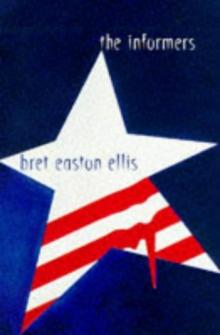 The Informers
The Informers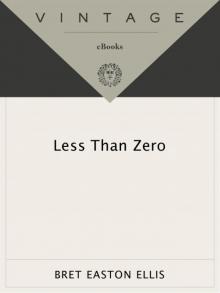 Less Than Zero
Less Than Zero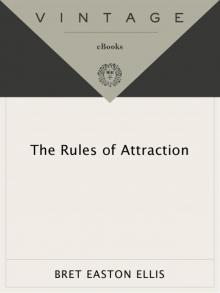 The Rules of Attraction
The Rules of Attraction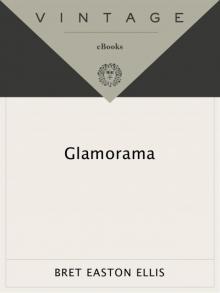 Glamorama
Glamorama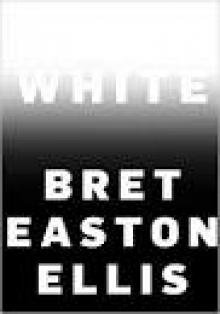 White
White